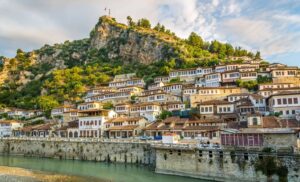
Participants in the panel discussion “Connecting Economies: Cross-border Infrastructure and the Power of Partnership” at the Ukraine Recovery Forum in Bucharest emphasized that the development of border infrastructure and joint projects is a key condition for unlocking the economic potential of Ukrainian-Romanian cooperation, especially in the border regions of Chernivtsi and Zakarpattia Oblasts.
The discussion was moderated by Bogdan Bernyage, senior associate expert at the New Strategy Center (Romania). The panel was attended by Gheorghe Șoldan, chairman of the Suceava County Council (Romania), Mykhailo Pavliuk, deputy chairman of the Chernivtsi Regional Council, and Andrii Sheketa, first deputy chairman of the Zakarpattia Regional Council.
According to the participants, the economic partnership between Chernivtsi region and Romania is of strategic importance: Romania accounts for over 20% of the region’s foreign trade turnover. There is significant potential for deepening cooperation in the woodworking industry, where Chernivtsi’s raw material base can be combined with the processing capacities of the Romanian side. Opportunities for the development of joint projects in the fields of IT, tourism, agriculture, and transport were also noted. “Our regions are already closely linked by trade, the next step is to move from simple exports of raw materials to joint production chains,” Pavliuk said.
With regard to Zakarpattia, the participants emphasized that the reconstruction of the region is closely linked to its long-term development and the deepening of ties with Romania. Despite the fact that the region has the longest section of the common border with this country, the border infrastructure remains underdeveloped, and a number of checkpoints operate below their potential capacity. According to Sheketa, targeted infrastructure investments—in roads, rail approaches, and the modernization of border crossing points—are a necessary condition for improving connections between Transcarpathia and Romania and for making fuller use of the opportunities for cross-border cooperation.
Following the discussion, the participants concluded that the development of joint projects and the modernization of border infrastructure could strengthen the economic integration of border regions and create additional opportunities for business and employment on both sides of the border.

Mexico’s economy contracted by 0.3% in the third quarter relative to the previous three months, according to final data from the country’s statistics office. The estimate matched preliminary data. Analysts on average also did not expect a revision, Trading Economics reported.
The downturn in the economy is being recorded for the first time since the fourth quarter of last year. Mexico’s GDP grew 0.6% in the second quarter.
Mexico’s economy contracted at an annualized rate of 0.1% in the third quarter. A contraction of 0.2% was previously reported.
The Experts Club analytical center has previously made a video analysis and forecast on the macroeconomy of Ukraine and major countries of the world.
https://youtu.be/kQsH3lUvMKo?si=1StxlkcIzQlpF0_q
ECONOMY, economy macroeconomy, EXPERTS CLUB, MACROECONOMY, MAXIM URAKIN

The Experts Club analytical center analyzed Albania’s economy for the first 10 months of 2025 and presented its analysis and forecast. Based on the results of the first ten months of 2025, Albania continues to have one of the highest growth rates in Europe, with low inflation, stable currency reserves, and continued growth in tourism, but it faces a slowdown in industrial output and an expanding trade deficit.
According to IMF mission estimates and national statistics, Albania’s real GDP grew by approximately 3.4–3.6% year-on-year in the first half of 2025, which is comparable to 2024 figures and above the European average. The main drivers of growth remain the service sector, construction, and tourism: foreign tourists alone spent around €2.1 billion in the country in the first six months, which is 7–8% more than a year earlier.
International institutions expect the economy to grow by around 3.4-3.7% by the end of the year: after its autumn mission, the IMF raised its forecast to 3.5% for 2025, while the World Bank and the EBRD also expect growth of over 3%.
Inflation in the country remains low and close to the target level. According to the IMF and national statistics, annual consumer price inflation in 2025 is around 2–2.3%.
The labor market situation is improving moderately. The unemployment rate in the second quarter of 2025 fell to 8.5%, which is significantly below the historical average (around 14%).
Industry remains the most vulnerable sector. According to estimates by research centers and statistics, industrial production in Albania in the first quarter of 2025 declined by approximately 2.1% compared to the same period in 2024, while in the second quarter the decline slowed to around 0.5%. Manufacturing output in June 2025 was 0.9% lower than a year ago. This reflects the problems of traditional export industries, primarily textiles and clothing, which are under pressure due to the strengthening of the national currency and demographic outflow.
The external sector remains a weak spot in the macroeconomy. According to Albanian think tanks and INSTAT, the trade deficit in goods widened to about 25.3% of GDP in the first half of 2025, despite high tourism revenues. Remittances from migrants grew by about 5% to €1.2 billion, remaining an important source of external revenue, while foreign direct investment stabilized at around €1.1 billion over the same period.
At the same time, external stability appears comfortable. According to Trading Economics, Albania’s international reserves reached $7.3 billion in September 2025. In its final Article IV statement, the IMF explicitly notes “strong reserves, declining public debt, and one of the highest growth rates in Europe” as a basis for further reforms and deeper integration with the EU.

Spain’s GDP grew by 0.6% in the third quarter of 2025 compared to the previous three months, according to preliminary data from the national statistics agency INE. Economic growth compared to the same period last year was 2.8%.
Analysts had forecast an average increase of 0.6% for the first indicator and 3% for the second.
The pace of growth slowed: in the second quarter, GDP rose by 0.8% quarter-on-quarter and 3.1% year-on-year.
Consumer spending in Spain rose by 1.2% in July-September compared to the previous quarter, business investment by 1.7%, and government spending by 1.1%.
Exports of goods and services fell by 0.6%, while imports rose by 1.1%.
Industrial production rose by 0.5%. The services sector showed an increase of 0.8%, and the construction industry also rose by 0.8%.
http://relocation.com.ua/vvp-ispanii-v-iii-kvartali-zris-lyshe-na-06/

In September, the Chinese economy showed higher-than-expected growth rates in industry and retail trade, indicating a gradual recovery in domestic demand and business activity.
According to the National Bureau of Statistics of China, industrial production grew by 6.5% year-on-year, the highest rate since June. In August, growth was 5.2%, and analysts had expected a slowdown to 5%.
The largest contributors were:
manufacturing — +7.3%,
mining — +6.4%,
oil and gas — +8.9%,
automobile production — +16%,
computers and telecommunications equipment — +11.3%.
Growth was recorded in 36 of 41 sectors of the economy. Overall, industrial production increased by 6.2% in the first nine months of 2025 compared to the same period last year.
Retail sales in September grew by 3% year-on-year. This is slightly less than in August (3.4%), but still better than analysts’ forecasts (2.9%).
The largest increases were in sales of food products (+6.3%), jewelry (+9.7%), and clothing (+4.7%). Car sales rose by 1.6%, while petroleum product sales fell by 7.1%.
Since the beginning of the year, retail turnover has reached 36.6 trillion yuan (about $5.1 trillion), which is 4.5% more than a year earlier.
Investments in fixed assets as a whole declined slightly, by 0.5%, mainly due to a decline in the construction sector (-13.9%). At the same time, investments in infrastructure and manufacturing grew by 1.1% and 4%, respectively.
The unemployment rate in September fell to 5.2% from 5.3% a month earlier.
Experts from the Experts Club analytical center note that the Chinese economy remains stable despite the slowdown in global demand and difficulties in the real estate sector.
Reference: Experts Club.
For several years now, China has ranked first in the world in terms of economic size, calculated in terms of purchasing power parity (PPP), ahead of the US and the EU. This confirms its status as the largest industrial and consumer center on the planet.

Small and medium-sized businesses (SMEs) remain the foundation of post-war economic recovery, and this segment will be the focus for Sens Bank in 2025–2026, said Yana Shumunova, director of the SME department, in an interview with Interfax-Ukraine.
“We are seeing growth in demand for loans to restore logistics, purchase equipment, and implement energy-efficient solutions. This is the foundation for the return of Ukrainian business to sustainable growth,” she said.
The bank is also strengthening its cooperation with the EBRD and international funds to expand SME lending programs.
Sens Bank is a Ukrainian universal bank specializing in the corporate and retail segments. After coming under state control, the bank is transforming its business model, focusing on technology, transparency, and support for SMEs.